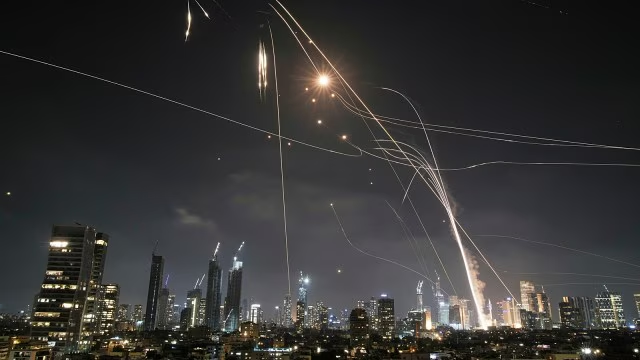As Iran and Israel’s escalating tensions rattle the Middle East, India finds itself grappling with far-reaching consequences. Experts warn of trade disruptions, shipping delays, and inflationary pressure as vital routes like the Strait of Hormuz grow unstable. For a country deeply reliant on energy imports and export markets in West Asia, the economic stakes have never been higher.
India’s Trade Shakes as Iran-Israel Feud Escalates: Experts Caution of Ripple Effects
The intensifying struggle between Iran and Israel has started to extend well beyond the original land of conflict. But as tensions rise, Indian exporters and trade experts are warning of a growing toll on India’s crucial trade relationships with West Asian countries. And with the situation pitting a major U.S. ally against crucial maritime routes and economic alliances, the repercussions could be enormous, not only for businesses at home but also for consumers.
A War With Economic Collateral
An initial local dispute has turned into an international arm-wrestle. The United States finally struck on three targets in Iran days into June in a dramatic reversal. The strikes were ostensibly aimed at setting back Iran’s nuclear program, which Israel views as an existential threat. But in so doing, Washington has vastly increased the risk of a broader regional war — and India, one of the region’s crucial trading partners, could find itself in the cross hairs.
“We’re in big trouble now as a result of this war. This would have a ripple effect on the country’s trade with West Asian nations,” cautions Sharad Kumar Saraf, a longtime exporter and founder chairman of Technocraft Industries India. His company, which produces commodity items like drum closures and clamps, has already delayed shipments to Iran and Israel because of elevated risks.
Trade Flow Disruptions Already Underway
The strain is already visible. Exports to Israel and Iran from India are also on a downtrend. Hostile maritime chokepoints, such as the Strait of Hormuz and the Red Sea, are also increasingly volatile, adding another layer of complexity to logistics.
- Indian traders were already dealing with the aftermath of the Israel-Hamas conflict.
- Houthi rebels in Yemen launched attacks on commercial boats in the Red Sea.
- Numerous shipping companies rerouted around the Cape of Good Hope – a more expensive route.
Now, another major trade route, the Strait of Hormuz, is endangered. This waterway is crucial for global oil trade and is an economic lifeline for India, which buys more than 80 percent of its energy requirements. A blockade, or even a prolonged military interruption, of this narrow channel would be catastrophic.
“I have a feeling that oil tankers will find new routes but that will push up crude oil prices. What if one tanker is hit in the shipping route? It will have impact on inflation as crude related prices is mother of all prices,” Saraf added.
GTRI Analysis: What’s At Stake
These concerns have been reiterated by the Global Trade Research Initiative (GTRI), one of India’s premier think tanks. The stakes are very high, according to its founder Ajay Srivastava. India’s trade with the rest of West Asia (Iraq, Jordan, Lebanon, Syria, and Yemen) adds up to an equally large USD 41.7 billion (exports of USD 8.6 billion and imports of USD 33.1 billion).
“Any disruption to the shipping lanes, port access or financial systems in this corridor would seriously affect India’s trade flows, increase freight and insurance costs and bring in new supply chain risks for Indian businesses,” Srivastava said.
Real-time trade data:
- India exports to Iran (FY2025): USD 1.24 billion
- Basmati rice: USD 753.2 million
- Banana: USD 53.2 million
- Soya meal: USD 70.6 million
- Bengal gram: USD 27.9 million
- Tea: USD 25.5 million
- Imports from Iran: USD 441.8 million
- Trade with Israel (2024-25):
- Exports: USD 2.1 billion
- Imports: USD 1.6 billion
Further hostilities or sanctions, particularly some linked to the US, could potentially clog financial channels and shipping routes. Payment systems already stressed by the current United States sanctions against Iran could collapse under added prohibitions, resulting in delays and extra costs.
Agricultural Sector Faces the Heat
Srivastava specifically noted the potential dangers to perishable commodities. With little going in or out, the Gulf has turned into a nightmare in terms of logistics, leaving food exports, like rice, bananas and tea, stranded to spoil – something that carries the potential to severely impact India’s agri-export sector.
“A longer conflict could slow Iranian demand and put pressure on Indian exporters, particularly in agriculture,” he added.
India’s ancient cultural and historical connections to Iran complicates the picture even more. There could be challenges for the Chabahar Port, considered as a strategic asset by India. This is the port through which Afghanistan and Central Asia can be reached, it is also an option to the Pakistan route.
Strait of Hormuz: The Most Important Oil Chokepoint in the World
The greatest present threat is the potential for the Strait of Hormuz to be blocked. This narrow strait, just 21 miles wide at its narrowest point, is a crucial artery of the world’s energy trade. It carries almost 20 percent of the world’s oil as well as sizable volumes of India’s crude and liquefied natural gas purchases.
India’s reliance is clear:
- More than 60-65 percent of Indian crude imports pass this strait
- Half of India’s LNG imports are also through this route
- It supports oil exports from Saudi Arabia, Iraq, Iran, Kuwait and the UAE
The implications of Iran actually closing it, if it follows through on that threat, could be dramatic. The fact that we came so close to that happening, and kept the potential for its occurring in view with the military build-up that we had, were not lost on Iran.
“It would seriously undermine India’s energy security, lead to an increase in oil prices, and create inflationary pressures in the country,” GTRI cautioned.
Rising Inflation and Currency Pressure
Oil prices that are rising rapidly and shippers that are rerouting vessels will inevitably add to inflation at home. These could also spark currency depreciation, thus making fiscal management more challenging for the Indian government, the think tank added.
“The closure or military disruption in the Strait of Hormuz would cause a steep rise in the price of oil, freight costs and insurance coverage, inducing inflation, putting pressure on the rupee and complicating the fiscal picture for India,” GTRI added.
Red Sea Crisis Adds to Woes
India’s trade network was already facing bottlenecks. The Israel-Hamas fighting that was launched by an October 7, 2023, attack on Israel, has prompted Houthi rebel attacks on ships in the Red Sea. This has effectively paralysed the movement of cargo via this key trade route.
Key figures underscore the magnitude:
- 80% of India’s merchandise trade with Europe is via the Red Sea
- The US and Europe are responsible for 34% of India’s overall exports
- Red Sea Strait accounts for 30% of global container flow
- About 12 percent of the world’s trade moves through this route
In a year of economic upheaval caused by the pandemic, any extra pressure on international shipping networks could translate into delays, more expensive products and frustrated businesses waiting for goods to arrive.
Global trade: a forecast and how India fared
Even before the latest escalation, trade forecasts were looking downbeat. The World Trade Organization (WTO) has just revised its forecast and says that global trade will decline by 0.2% in 2025 compared to its previous projection of a 2.7% increase.
But India had fared relatively well:
- India’s total Exports (2024-25): USD 825 billion, growing 6% YoY
- 2025 target: likely more than USD 900 billion
But that momentum now seems to be at risk. In May 2025, shipments fell 2.17 percent year-on-year, led by a decline in petroleum-related exports. Should conditions deteriorate further, the $900 billion target could come to appear increasingly cynical.
Conclusion
The rise in hostilities between Iran and Israel are no longer an internal regional issue but a spreading global crisis with economic fallout, making India one of the most vulnerable players. From volatility in oil prices to port blockades and shipping delays, the knock-on effects could hit India’s exports, as well as the management of its currency and inflation, hard.
For a nation that imports the majority of its energy requirements and is heavily reliant on sea trade routes passing through West Asia, the stakes are high. Given the increasingly uncertain geopolitical environment, Indian policymakers, exporters, and trade bodies need to prepare for disruptions lasting much longer and a new global trade order.
FAQs
Q1: How has the Iran-Israel struggle affected India’s trade till date?
A: Exports to both Iran and Israel have declined, and shipping through the Red Sea and past the Strait of Hormuz have become more dangerous and costly.
Q2: Why the Strait of Hormuz is important for India?
A: Roughly 60-65 percent of India’s imported crude oil and almost half of its LNG imports pass through the strait, and so it is important in terms of energy security.
Q3: What does India export to Iran?
A: Basmati rice (USD 753.2 mn), banana (USD 53.2 mn), soya meal (USD 70.6 mn), Bengal gram (USD 27.9 mn) and tea (USD 25.5 mn).
Q4: What shipping routes are in danger?
A: The Red Sea route is crucial for trade with Europe and the US, and has already been disrupted by Houthi rebel attacks on commercial ships.
Q5: What could be the impact of this situation on the Indian economy?
A: Higher oil prices, inflation, a weaker currency, and higher shipping costs could pressure India’s fiscal health and disrupt trade targets.
Reference
Iran-Israel war escalation to impact India’s trade with West Asia, say experts
Stay updated with all the latest news and insights – News Of US






